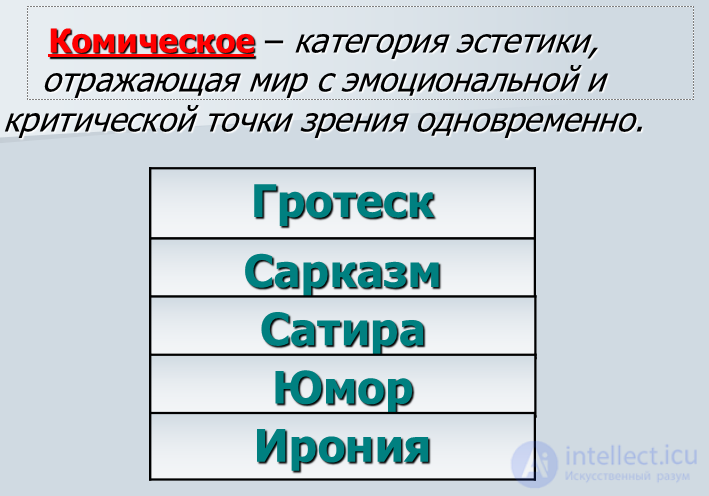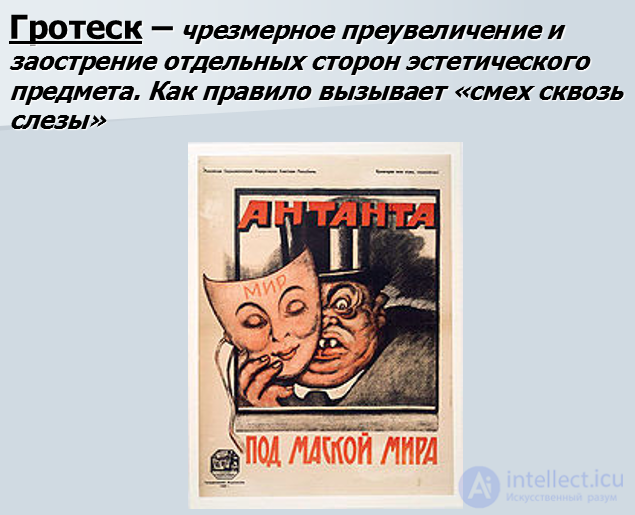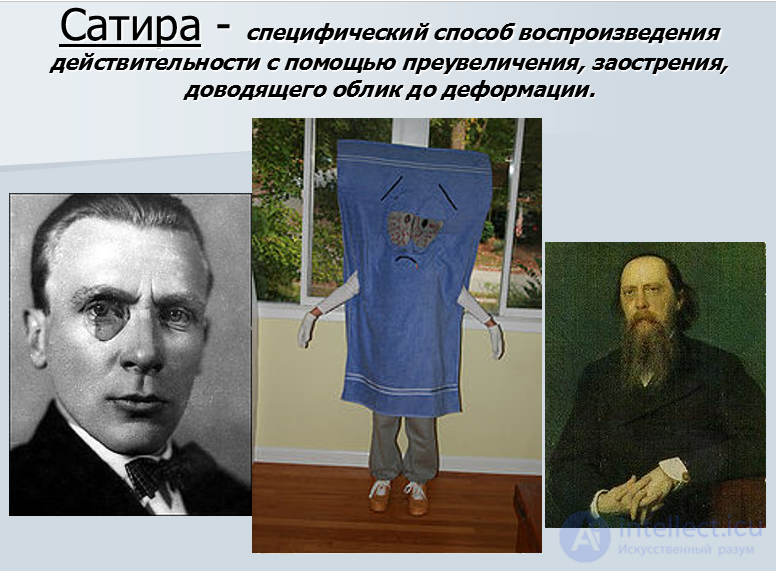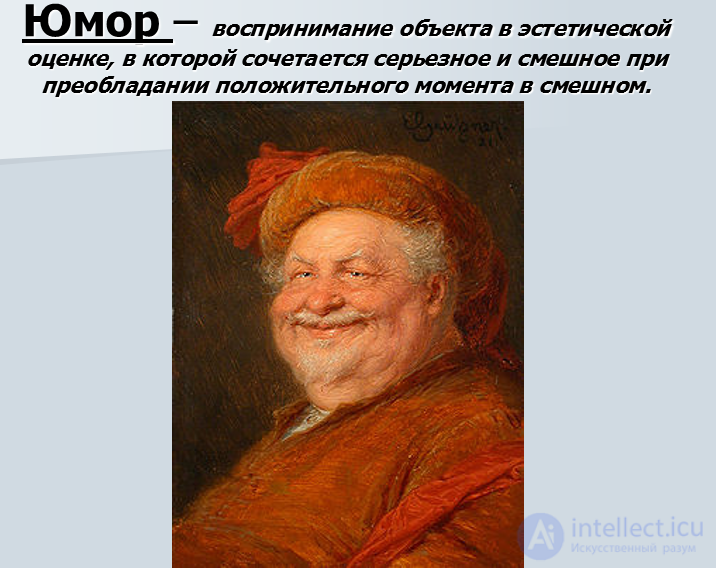Lecture
Internal interrelations of aesthetics categories become complete in the comic, because it fixes the absence of spiritual grounds in phenomena for asserting and affirming an idea in the image. The category comic reflects the contradictions of life in the form of aesthetic elevation over its negative manifestations and overcoming the deficiencies of its carriers with laughter. comic due to their internal inconsistency, and with what spiritual limitations seeks to disguise an outwardly spectacular form. In the history of aesthetic characterized comic thought as a consequence contradiction ugly - Excellent (Aristotle), low - Raise Sene (Kant), false - significant (r Gegel) insignificant - great (Lipps) etc. It seems that the most clear definition of the comic belongs to M. Chernyshevsky. In the thesis The aesthetic relationship of the mystery to reality the philosopher writes: comic - internal emptiness and nothingness, which is disguised by appearance, which claims to be content and real value [20, 97] Thus, he expands the definition of the German philosopher, student of G, Hegel, Ft Fischer ( Aesthetics, or the science of the beautiful ), who writes: Comic is an advantage of the image over the idea of writing:" Komichne - Tse peregaga image on d іdeєyu ".

Began to develop the aesthetics of the comic belong to Plato (treatises Fileb , Feast ) and Aristotle ( Poetics ) In ancient Rome, the comic researcher was Cicero ( About the orator , On duties ) Per day Serednyovicha laughter is outside the official spheres of ideology. Early Christianity condemns laughter (Tertullian, Cyprian, John Chrysostom, Clement of Alexandria), believing that only seriousness of the development of the comedy genre in the Renaissance, as well as the translation of Poetics Aristotle promoted interest in the theory comic (treatises Mudge About comic , Discourse on tragedy and comedy ) P. Ethan comic touches upon in his works R. Descartes, B. Spinoza, T. Hobbes, D. Hume in connection with the study of the nature of affects. Differences of high style (tragedy ) and low (comedy) are disclosed in the treatises of B Walo On poetic art and Dubot Critical discourses on poetry and painting The theory of the comic acquires a comprehensive understanding of the aesthetics of the Enlightenment (Shaftesbury, Diderot, Lessing, Voltaire) and Romance tism (Schelling, Jean-Paul, Kant, Schlegel, Hegel, Heine) Theor and laughter devoted to the works of Bergson A of laughter, 3 Freud Jokes and Their Relation to the free soznatelnogoe). Theory smihu attributed A. Bergson's pratsi "About smіh", 3. Freyda "Dotepnya that її vіdnoshennya to without sv_domogo."
Aesthetic theory revealed the expressiveness of self-expression of comic phenomena, emphasizing that it is a negative form of aesthetic reaction to the limitedness of their content is laughter Laughing reaction to negative is a way of creating a relationship between him and the spiritual position of the subject of a relationship. Therefore, laughter over negative has a cathartic effect. His goal is to focus attention on flaws, contradictions and glaring flaws of the phenomenon. By means of laughter, the negation of the normative opens so brightly that its flaws I am obvious and it becomes extremely difficult to mask them. Laughter is a kind of doctor of life: the catharsis effect has a cleansing effect, releasing the mind in the burden of negative manifestations of life, giving rise to a feeling of hopelessness. Dropping the pedestal of the phenomenon and persons, possession without justification, laughter dispels imaginary values By forming a conscious approach to reality instead of an aesthetically pleasing, Laughing reaction to a negative means that the person has not dissolved into the negative, has not perceived it, but has risen above In terms of superiority, laughter reacts to negative aggression of aesthetic qualities of reality is reflected in the ambivalence of perception by their subject. The aesthetically defined direction of laughter as an important source of the struggle for perfection emphasized M Guo gol He noted: The last scoundrel is afraid of laughter, too, is indifferent, even the one who is not afraid of anything is afraid. So he serves a good cause [7, with good help" [7, p. 135].

Note that the laughter reaction does not extend to the physical defects of a person - human misfortune Moral feeling puts a ban on negative reaction and translates it into spiritual interaction - sincere sympathy Vboli Ivanna, the desire to help is an aesthetic response to these phenomena. Moreover, if a person, despite on physical weakness, injury, did not submit to circumstances, and lives a spiritually rich life, our reagent, Anna, takes on the character of exalted admiration for willpower and courage.
upholding the field of beauty and good by aesthetically determined means means crowding out evil and anti-aesthetic, that is, has a morally balanced character. The comic reveals the weaknesses of the phenomena and, in an aesthetic way, in a certain way - with the help of an adequate measure of laughter - contributes to their improvement, laughter does not prevent the full self-realization of the phenomenon. It hurts, sometimes it hurts, and with it helps to overcome negative aspects of reality object If the phenomenon is not able to change for the better, laughter has this inability, i.e. testifies to the aesthetic exhaustion of his qualities It is precisely for this reason that phenomena that become obsolete show such ?? vulnerability to laughter The value of laughter in this case - in its cleansing diya dії.
In difficult situations, the clash of old and new life-giving power of laughter contributes to decisive progress into an unknown future. Laughter helps to say goodbye to the past. The moral justification of laughter over the outdated is due to objective reasons: it is laughter at the attempt of the phenomenon to determine the course of events and serve as moral authority. then when it turns out to be groundless. Pre Tenzo significance. So, laughter does a good deed in all cases when its purpose is to refute false Ennoses and thus the liberation of consciousness for the newer, more perfect in human beings with angstroms, in public life, spiritual experience, etc. In the Forts, she determined the value direction of a critical attitude to reality, characteristic of the comic, as a dialectical process: Because the destruction of tation is such a function of the comic in the development of mankind "[19, p 91] [19, p. 91].

Laughter is a means of relieving energetic tension, a way to get rid of phenomena, frighten by inevitability and inevitability. Thus, humanity is saved with laughter from the fear of death: in the culture of many nations, death masks are an indispensable attribute of a carnival action. this is peculiar to the folk culture of the laughter optimistic, life-affirming beginning of the ambivalence of the image and optimism - the aesthetic characteristics of the people executing culture - they feed on the personal character of laughter, a ridiculous vision of the world - not the product of a separate person, but revealing the general perception of life by the folk choral whole. Confidence in overcoming evil and enthusiasm to resist it gives rise to commonality of feelings - because it laughs to be peaceful" all svit ".

People's laughter culture - a concept introduced by M. Bakhtin to determine the place of the comic in the life of a people, appears as a manifestation of internal resistance to power and coercion. The scientist notes ambivalence and folk culture of laughter, i.e. integrity of the negative affirmative content of laughter [2, p. 21] Folk culture has developed a mass - carnival form of manifestation of unity of feeling. The carnival does not know the separation between people and participants. Everyone participates in mass action, thus gaining a sense of universal unity by carnival. folk power and spiritual preferences Carnival - one of the stable forms of creating a relationship of feelings that had developed in the times of ancient Vava, Lona, later spread to the territory In the Roman Empire, then in medieval Europe, it was widely rooted in the culture of the countries of Latin America, where it fell after the discovery of the American continent to Europe and Europe by Europeans.
The forms in which the response to negative phenomena was carried out formed a certain associative array, that is, they had not a direct, but a hidden character. Consequently, the aesthetic response arose as an objective consequence to the perception of the form of manifestation of the phenomenon, and then, in the process of thinking about the form, the hidden deep laughter layer of content Let's say, the buffoonish of Kievan Rus, the clowns in the royal and royal palaces of Europe had the privilege of telling the truth, but only in the clownish , comic ( not obligatory flaxen ) form The social situation of these people ( off-line ) should have testified that they say from anyone , and therefore it’s not necessary to take their words, as well as to react to them However, in such non-binding Forms of hidden deep meaning, reflecting the rejection of violence of power over a person, carnival jesters' forms are also a way of producing a kinship of an aesthetic response to events that are dangerous to put in a comic light away from you , that is, to provide a response to individualized forms But since the object of laughter was often (and remains) the powerful of the world — rulers, bureaucrats, representatives of the spiritual and secular branches of power, it takes extraordinary courage to deny social structures as such, but to try to coercion, threats, frightening and violence, wield control before primus, terror, violence and violence.
Laughter is one of the most powerful aesthetically designed ways of self-expression aimed at one’s own face. The manifestation of a higher form of self-awareness is the ability to laugh at oneself. I realized my weaknesses And rose above them, making them the subject of sm ihu. So, internally she had already overcome them in her own way.
As well-known theorists of aesthetics (Schiller, Schelling, Gogol, Belinsky) have repeatedly noted, the ability to see shortcomings in oneself and laugh at them is the highest form of aesthetic education. This is not only about a certain person, but also about the health of a people who can laugh at themselves. This the problem is widely understood in the cited work of M. Bakhtin, in particular the relatively immortal power of people's life in the Middle Ages, the folk culture of laughter served as a kind of antipode of the heroic and tragic official the last Christian culture, rejecting the human body as sinful, the absolutes zuvala the value of its spiritual principle balancing the one-sidedness of such an understanding, the people asserted vitality and its sources as the basis of the eternal rebirth of life. Carnival and laughter over the material and physical bottom of man, his ambivalence, which is absorbing, and giving birth to the beginning.
The idea of the ambivalence of being as becoming is reproduced in carnival actions through the dialectic of death and immortality, whose symbols are, say, knives, murder, pregnancy, childbirth, fire The grotesque images of the human body are subordinate to this goal [2, pp. 274-275] On the aesthetic form of comic and its spiritual function, M Bakhtin notes: Laughter is not an external, but an essential internal form that cannot be changed into a serious one without destroying and without distorting the very content of truth revealed by a laugh [2, I 105ot; [2, p. 105].
In the Middle Ages common forms of folk culture of laughter, except for nationwide carnival laughter, were fablio (in France), svalki (in Germany), farce, animal epic (in Russia), and others. Gostros and the typical content of the works softened the ridiculous form and traditional methods of mocking Professional art created a rich culture of laughter, providing its manifestations of gradations and nuances in various forms of food - from acute (sarcasm, satire) to benevolent (humor, joke) and transitional (irony; (vironia).
Since antiquity, comic has entered the sphere of aesthetic thanks to the creative work of Aristophanes - an outstanding Greek comedian. He was the first in world culture to risk exposing the gods of Olympus in a comic light (comedy Clouds ). Comic comes to the new European culture from the Renaissance, creating a rich treasury of artistic forms Laughing Vision of the World To world-renowned masters of laughter n. J Boccaccio (Italy), In von Hutten (Germany), E. Rotterdam (Holland), In Shakespeare (England), M Cervantes ( Spania), F. Rabelais (France) It is in the works of these artists consist of aesthetic and comic forms: satire, sarcasm, irony, humor, joke (True, Cicero already in the treatise About the orator defines such kinds of funny as wit, humor , irony, irony) Separate forms of comic zba Gachuwalis and perfected in the post-Renaissance period Let's say in romanticism one of the leading artistic means of expressing the hero's world outlook was romantic irony. Great contribution to the art of comic art and its aesthetics made German, English, American Romanticism (Hoffmann, Heine, Byron, Shelley, Poe) of Western European and East Slavic cultures enriched the artistic practice of ku and aesthetic theory with sharp satirical forms thanks to the work of J. Swift (England), M. Saltykov-Shchedrin (Russia), T. Shevchenko and M. Gogol (Ukraine), T. Shevchenko and M. Gogol (Ukraine).
Comic - one of the forms of man’s freedom in freedom This is a way to get rid of seriousness, which is inherent in everyday consciousness, inclined to raise small values to the rank of the highest, to give them a global meaning. Nietzsche aptly defined the comic as artistic liberation from disgust, caused by meaningless [ 15, with 83t; [15, p. 83].

So, the main forms of comic, formed in the historical experience of humanity's response to the phenomena of reality, are: sarcasm, satire, irony, humor, joke. They are a gradation of the ability of its laughter reaction to negative phenomena.
Humor is a kind of comic, reflecting the specifics of the aesthetic experience of the contradiction of the subject of perception: as a combination of serious and humorous beginnings. A peculiarity of humor assertion of the object of indifference is an emphasis on the spiritual value of its qualities. attention to the essential while ignoring the minor and petty - irrelevant details of life Situations arising from this, give the effect of surprise, enhancing the positive assessment of the phenomenon of humorous and friendly laughter, and therefore not removed from the subject but, on the contrary, is basically an affirmative. The theory of humor is extensively developed in the aesthetics of romantics, in particular, in Jean-Paul's "Preparatory School of Aesthetics "It contains an analysis of funny, humor, satire, burlesque, ironiburlescu, ironia.
Irony is a special kind of comic and a category of aesthetic attitude, reflecting the duality of meaning: visible and hidden. This is the opposite relationship, in which behind the outwardly positive form of evaluation lies a mocking and negatively negative sense rooted in culture since antiquity, but has gained widespread use in the era Renaissance in the philosophy of humanists, subsequently - in the philosophy and aesthetics of the Enlightenment and Romanticism. In the aesthetics of Solger, irony is interpreted as the central principle of creativity, mediating t all components of the work of art as a whole, building them according to its dialectical unity: reality and ideal, objective and subjective, material and idea, etc. Irony is also viewed as a property of historical life itself and the consequences of human efforts, translated by the objective logic of the development of phenomena into its opposite.
Satire (from lat. Satura - jumble) is an acute and mocking form of emotional-aesthetic attitude, denies the very essence of the object of ridicule, and consequently, its right to exist in aesthetic way regarding the manifestation of the inner nullity of the phenomenon due to the aggravation of its shortcomings, hyperbolization (exaggeration ), что акцентирует черты несовершенства Идеал утверждается средствами сатиры через разоблачения анти идет алу Эффект проявления несовершенства средствами сатиры настолько действенный, что, как отмечал М Че рнышевский, заставляет публику встряхнуться, вызывая отвращение и гнев Сатира индивидуализирует предмет отношения, за глиблюючись в его содержание, чтобы открыть несоответствие образа и идеи, профанацию идеи в образе Поэтому сатира имеет национальный и исторический смысл, конкретную направленность на выявление безобразного, пр Агне спрятаться под маской значимого и возвышенного Особой силы и эстетической выразительности сатира приобретает в сутки критического реализма, хотя замечательные ее образцы имеются и в искусстве Возрожден ия (Роттердамский ий) и Просвещения (Свифтий) та Просвітництва (Свіфт).
Сарказм (от греч sarkazmoz - рву мясо) - едкая и едкая ирония, имеющая целью разоблачения явления из-за издевательств над ним, не оставляя никаких иллюзий относительно его качеств Она не только больно ранит, но и отрицает право явления на существование Эстетическая форма, в которой осуществляется возражения, усиленный контраст между текстом и подтекстом, тем, что имеется в виду относительно сущности явления, и тем, как эта сущность е дкриваеться в способах ее выраженияння.
Итак, предметом комического есть явления безобразного и низкого, которые побеждают смех, в частности такие его эстетические формы, как сатира и сарказм Дифференциация этих форм чрезвычайно важна учитывая эстетической м меры смеха Ведь несоответствие степени способна разрушать духовно ценные явления Поэтому применение эстетической меры смеха - необходимое условие эстетически определенного отношения к явлениям действительности Характер смеха с а для сохранения своей эстетической определенности всегда должен содержать ориентацию на идею совершенства, а потому его мера должна быть всегда детерминирована уровнем негативности явления Поскольку градация рис не отрицательно в явлениях чрезвычайно широка, амплитуда эстетического реагирования в форме комического так же разнообразна Это смех от шутливого, доброжелательного, одобрительного - юмористического к острому, разоблачена тельного, сокрушительный - сатирического Только таким образом, то есть через эстетическую мере, смех открывается своей моральной определенностью и только таким образом способен влиять на жизнь, то есть расширять и совершенствовать сферу естетичногтичного.
Эстетическая мера смеха определяет также уровень способности явления к самосовершенствованию: сознательного устранения рис, дискредитирующие его, вызывая негативную реакцию на проявленную ограниченность Поэтому моральный в и эстетическую максиму смеховой культуры можно сформулировать так: смеяться над негативным нужно и даже необходимо, однако, степень смеха не должна превышать черты явлений, чтобы не приобрести Дестро уктивного, разрушительного характеру.
Разрушая высокое и духовно ценное, смех приобретает циничного, деструктивного характера Безосновательное насмешки - зло, потому что разрушает духовные структуры личности, дезориентирует его в жизни, намагаю сражаясь подменить высокое и благородное низким и безобразным Эстетическая мера смеха чрезвычайно важна в педагогическом процессе Речь идет не только о том, что шутка - не наиболее уместна и эстетически оформленная реакция на возможное несоответствие поведения ученика ситуации школьной жизни Он значительно весомее педагогический эффект, ведь отсутствует назидательность, что создает дистанцию ??между учителем и учеником Кроме тог о, остроумная шутка - это объемная и одновременно оформлена в образ реакция, что, унижая достоинства ученика, помогает посмотреть на свой поступок со стороны и осознать его несоответствия есть, смеховая реакция у форме шутки действует более убедительно и влияет значительно эффективнее, задействуя эмоциональную сферу виновника созданной ситуациитуації.
Clearly, a laughter reaction is justified when it comes to inappropriate behavior caused by ignorance of the situation or incomplete possession of information about it. However, it is inappropriate and harmful if this is an amoral act, the cynicism of adolescent judgments, etc. Laughter is powerless when cruelty, insidiousness, threat to the honor or life of others induces an act. Note that the educational effect of the comic is really effective only when an aesthetically balanced form of the application of laughter is found. It should not contain any encroachment on the honor and human dignity of the person.
Friendly laughter is widely used as an effective means of verifying the degree of value of a phenomenon. Personality reflects on himself, sometimes in the form of a joke he notices his own weaknesses in front of us and others, disarming our potential opponents, independently concluding on the need to eliminate negative comments. moments.
So, the comic manifests itself in the system of aesthetic categories as an attitude, effectively using its own means realizes the idea of improving reality or negating the negative in it, or focusing its flaws on the region, thus contributing to the elimination of rice, inhibiting the fullness of aesthetic manifestations. Laughter reaction can also assert aesthetic value phenomena, emphasizing the approving attitude to the victory in them of the spiritual, eternal over the fluid, secondary, irrelevant.
Comments
To leave a comment
Aesthetics
Terms: Aesthetics